List of neighborhoods in Seattle
The city of Seattle, Washington, contains many districts and neighborhoods. The city's former mayor Greg Nickels has described it as "a city of neighborhoods".[1][2][3] Early European settlers established widely scattered settlements on the surrounding hills, which grew into neighborhoods and autonomous towns. Conurbations tended to grow from such towns or from unincorporated areas around trolley stops during the 19th and early 20th centuries; the city has consequently suffered from transportation and street-naming problems.[4]
Definition of Seattle neighborhoods
[edit]

Seattle was established during an economic boom fueled by the timber industry; its early years were characterized by hasty expansion and development, under which residential areas were loosely defined by widely scattered plats.[5] This arrangement was further solidified by the establishment of locally initiated community clubs, public libraries, public schools, and public parks, which created a sense of community and civic participation.[citation needed] At the beginning of the 20th century, Seattle's community clubs became influential in the organization of public improvements. These had a significant effect upon the character of their neighborhoods and allowed them to remain distinct from the surrounding areas.[6][7] Some community clubs used covenants to restrict the ethnicity of residents.[8]
Establishing public library branches can define districts as well as neighborhoods. Public libraries are among the most heavily used buildings.[9] Seattle elected its city council at large from 1910 to 2014, and community clubs lobby councilors for the interests of local residents – such as for a library branch. The community organizations build a voting constituency, and in so doing define a neighborhood. In the absence of ward politics, this and campaign finance legislation are seen as more open alternatives. The Greenwood-Phinney Commercial Club was particularly active in organizing toward the Greenwood branch that opened in 1928.[10] The Lake City Branch Library opened in 1935 as a few shelves of books in part of a room in Lake City School, shared with the Works Progress Administration (WPA), sponsored by the Pacific Improvement Club community group. The library moved into a new building in 1955.[11]
Elementary public schools effectively defined many neighborhoods, which are often synonymous with the name of the elementary school when the neighborhood and school were established. Many of the neighborhoods contain a few smaller neighborhoods. Mann and Minor neighborhoods in the Central District, were built around their schools. The University Heights school (1903) in the north of the University District was named for the neighborhood, as was the Latona School (1906) in Wallingford.[12][13][14]
Parks similarly define some neighborhoods. Madrona Beach and Cowen and Ravenna Parks were privately established to encourage residential development upon otherwise unusable land.[15] The plan for Olmsted Parks fulfilled its goal and significantly influenced the character of neighborhoods around parks and playgrounds.[16] East Phinney and West Meridian neighborhoods are sometimes called Woodland Park, as well as South Green Lake or North Wallingford for Meridian.[17]
Covenants and racial restrictions
[edit]Housing covenants became common in the 1920s and were validated by the U.S. Supreme Court in 1926. Minorities were effectively limited to the International District and parts of some neighborhoods in south-east Seattle for Asian- and Native Americans; or the Central District for people of African ancestry, clearly defining those neighborhoods.[18] Ballard – Sunset Hill, Beacon Hill, Broadmoor, Green Lake, Laurelhurst, Magnolia, Queen Anne, South Lake City, and other Seattle neighborhoods and blocks had racially or ethnically restrictive housing covenants, such as the following sample:
No person or persons of [any of several minorities] blood, lineage, or extraction shall be permitted to occupy a portion of said property ... except a domestic servant or servants who may actually and in good faith be employed by white occupants.[19]
Further restrictions on conveyance (rental, lease, sale, transfer) were often included, effectively defining most of the neighborhoods in Seattle during the first decades after establishment.
The Supreme Court ruled in 1948 that racial restrictions would no longer be enforced. The Seattle Open Housing Ordinance became effective in 1968. Although unenforceable, legal complications prevent the covenants from being expunged from property title documents.[19][20]
Wards and Little City Halls
[edit]Seattle initially adopted a ward system; however, in 1910, this system was replaced by non-partisan, at-large representation. Variations on ward systems were proposed and rejected in 1914,[21] 1926,[22] 1974, 1995,[23] and 2003[24] and convictions for campaign-related money laundering followed the 1995 campaign.[25] Critics claimed that district-style elections of the city council would result in Tammany Hall-style politics. In 1973, inspired by Boston's model, Mayor Wes Uhlman's administration implemented a system of Little City Halls, where Community Service Centers (CSCs) assumed responsibility for coordinating municipal services. Uhlman's political opponents called the CSCs a thinly disguised ward system designed to promote Uhlman's reelection.[26] CSCs became a setting for political arguments between the city council and the mayor; controversies over accountability, cronyism, and ward politics occurred in 1974, 1976, and 1988. In 1991 the CSCs were renamed Neighborhood Service Centers (NSCs) and were placed under the jurisdiction of the Department of Neighborhoods.[26] More recently, their number has been reduced. As of 2011, there are NSCs located in Ballard, Lake City, the University District, the Central District, West Seattle, Southeast Seattle, and Delridge.[27]
Local improvement districts
[edit]A local improvement district (LID) is a method by which a group of property owners can share the cost of transportation infrastructure improvements. This involves improving the street, building sidewalks and installing stormwater management systems. Without Seattle's LID assessment system, the city would be unable to maintain its rapid growth in population and territory.[28] LIDs have helped define neighborhoods by localizing decisions about issues like sidewalks, vegetation and other features of the public space, permitting neighborhoods to remain distinct from their neighbors. [citation needed]
Informal districts
[edit]
No official neighborhood boundaries have existed in Seattle since 1910.[21][29] Districts and neighborhoods are thus informal;[30] their boundaries may overlap and multiple names may exist for a single district. Boundaries and names can be disputed or change over time. In 2002 a Department of Neighborhoods spokeswoman said, "I've seen my area go from the 'CD' to 'Madrona' to 'Greater Madison Valley' and now 'Madrona Park.' "[3] Some neighborhoods, such as northwest Seattle, do not have widely recognized names for their greater districts.
Throughout Seattle one can find signs indicating the boundaries of neighborhoods; the locations of these signs have been specified by the city's many community councils. However, the boundaries suggested by these signs routinely overlap and differ from delineations on maps. For example, signs indicate that Lake City Way NE is the southeastern boundary of the Maple Leaf neighborhood,[31][32] while the city clerk's archival map places that district's southern boundary at 85th Street.[33]
Another example of boundary ambiguity is "Frelard," which local residents call the area shared by Fremont and Ballard between 3rd and 8th Avenues NW. Signs facing opposite directions on NW Leary Way reveal the overlap.[12]
Further difficulty in defining neighborhoods can result from residents' identification with neighborhoods different from those marked on signs and maps. After an acrimonious development dispute in 1966, a group of concerned Wallingford citizens enlisted the University of Washington Community Development Bureau to survey their neighborhood; the survey revealed that more residents of southwest Wallingford considered themselves citizens of Fremont than of Wallingford.[12][13]
Transportation
[edit]Minor arterial roads are generally located along the boundaries of neighborhoods, with streets and highways built according to the street classification system.[34] These effectively help define neighborhoods.[35]
Development in accordance with the street classification system maintains the quality of life of city neighborhoods and improves efficiency of the road system. The classification system discourages rat running through local neighborhood streets.[36]
Transportation hubs, such as business zones and transit stations, such as Park and Ride facilities, provide focal points for districts of neighborhoods the same way trolley stops defined neighborhoods before cars.[citation needed]
Designated Historic Districts
[edit]The Department of Neighborhoods designates a number of Historic Districts, which have a similar status to Seattle Landmarks. As of 2021[update] these are:
- Ballard Avenue Landmark District
- Columbia City Landmark District
- Fort Lawton Landmark District
- Harvard-Belmont Landmark District
- International Special Review District
- Pike Place Market Historical District
- Pioneer Square Preservation District
- Sand Point Naval Air Station Landmark District
Source of list: [37]
List of districts and neighborhoods
[edit]Despite complications in Seattle's system of neighborhoods and districts, the names and boundaries in the following list are generally accepted and widely used.[38] They are based on the Seattle City Clerk's Neighborhood Map Atlas,[39] which in turn is based on a variety of sources, including a 1980 neighborhood map produced by the now-defunct Department of Community Development,[40] Seattle Public Library indexes, a 1984-1986 "Neighborhood Profiles" feature series in the Seattle Post-Intelligencer,[41] numerous park, land use and transportation planning studies, as well as records in the Seattle Municipal Archives.
The following table is largely based on maps from the Seattle City Clerk's Neighborhood Atlas, but also includes designations from other sources.
| Neighborhood name | Within larger district | Annexed[42] | Locator map | Street map | Image | Notes | |
|---|---|---|---|---|---|---|---|
| 1 | North Seattle | Seattle | Various | 
|
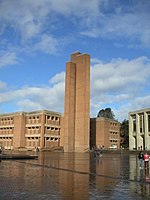
|
North of the Lake Washington Ship Canal[43] | |
| 2 | Broadview | North Seattle[43] | 1954[44] | 
|

|

|
[45] |
| 3 | Bitter Lake | North Seattle[43] | 1954[44] | 
|

|
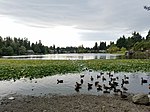
|
[46] |
| 4 | North Beach / Blue Ridge | North Seattle[43] | 1940,[44] 1954[44] | 
|
[47] | ||
| 5 | Crown Hill | North Seattle[43] | 1907,[48] 1952,[44] 1954[44] | 
|
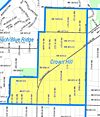
|
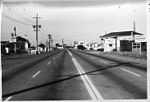
|
[49] |
| 6 | Greenwood | North Seattle[43] | 1891,[44] 1954[44] | 
|
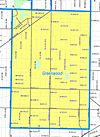
|
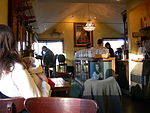
|
[50] |
| 7 | Northgate | North Seattle[43] | various 1891-1954[44] | 
|

|
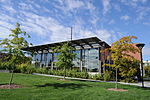
|
[51] |
| 8 | Haller Lake | Northgate[51] | 1954[44] | 
|

|
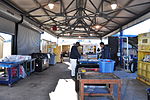
|
[52] |
| 9 | Pinehurst | Northgate[51] | 1953[44] | 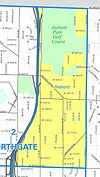
|
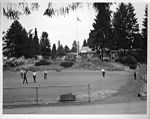
|
[53] | |
| 10 | North College Park |
Northgate[51] | 1950, 1954[44] | 
|

|
[54] | |
| 11 | Maple Leaf | Northgate[51] | 1891, 1907, 1941, 1945, 1949[44] | 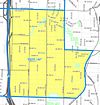
|
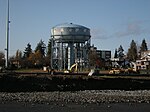
|
[55] | |
| 12 | Lake City | North Seattle[43] | 1953, 1954[44] | 
|
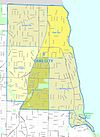
|

|
[56] Before annexation to Seattle, Lake City was a township for 5 years.[citation needed] Lake City neighborhoods are now also known as Sand Point-Magnuson Park and neighborhoods northwest of Sand Point.[citation needed] |
| 13 | Cedar Park | Lake City[56] | 1954[44] | 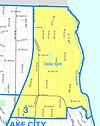
|
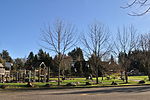
|
[57] | |
| 14 | Matthews Beach | Lake City[56] | 1953[44] | 
|
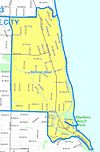
|
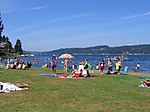
|
[58] |
| 15 | Meadowbrook | Lake City[56] | 1953[44] | 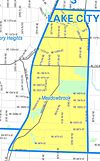
|
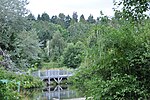
|
[59] | |
| 16 | Olympic Hills | Lake City[56] | 1954[44] | 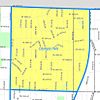
|

|
[60] | |
| 17 | Victory Heights | Lake City[56] | 1953, 1954[44] | 
|
[61] | ||
| 18 | Wedgwood | North Seattle[43] | 1945[44] | 
|

|
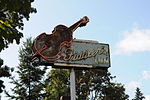
|
[62] |
| 19 | View Ridge | North Seattle[43] | 1942, 1953[44] | 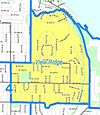
|
[63] | ||
| 20 | Sand Point | North Seattle[43] | 1910?, 1942?; 1953[44] | 
|
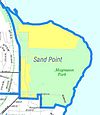
|
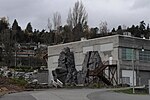
|
[64] |
| 21 | Roosevelt | North Seattle[43] | 1891[44] | 
|
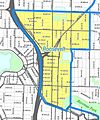
|
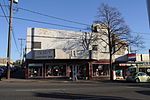
|
[65] |
| 22 | Ravenna | North Seattle[43] | 1907, 1910, 1941, 1943, 1945[44] | 
|
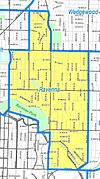
|
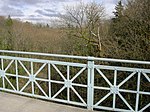
|
[66] The 1907 annexation was the former town of Ravenna. |
| 23 | Bryant | North Seattle[43] | 1891[44] | 
|
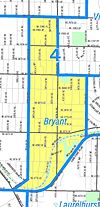
|
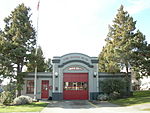
|
[67] |
| 24 | Windermere | North Seattle[43] | 1910[44] | 
|
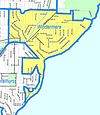
|

|
[68] |
| 25 | Hawthorne Hills | Windermere[43] / North Seattle | 1910[44] | 
|
Of the area the Seattle City Clerk's Neighborhood Atlas designates as "Windermere", many consider the area west of Sand Point Way to be a separate neighborhood, Hawthorne Hills. | ||
| 26 | Laurelhurst | North Seattle[43] | 1910[44] | 
|
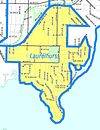
|
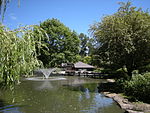
|
[69] |
| 27 | University District (U District) | North Seattle[43] | 1891[44] | 
|
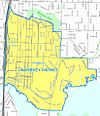
|
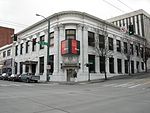  
|
[70] Known in the 1890s and 1900s as Brooklyn.[71] The main campus of the University of Washington is itself divided into the main (central) campus, plus the large South Campus (south of NE Pacific Street) and East Campus (east of Montlake Boulevard NE), and a smaller North Campus (north of NE 45th Street) and miscellaneous buildings west of 15th Avenue NE that are collectively known as West Campus.[72][73] Beyond the university, the district has a shopping district known as "The Ave" and older neighborhoods such as University Heights and University Park that are nowadays rarely distinguished from the U. District as such.[74] |
| 28 | University Village | Ravenna[43] / University District | 1891, 1907, 1910[44] | 
|
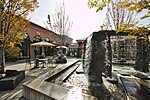
|
Primarily, the name 'University Village' refers to a shopping center at a corner of what the City Clerk considers part of Ravenna,[66] but it is also commonly used for the surrounding neighborhood on all sides, which ranges into what the City Clerk's maps consider Ravenna to the north and west and the east portion of the University District to the west. (To the south is the East Campus of the University of Washington.) | |
| 29 | Wallingford | North Seattle[43] | 1891[44] | 
|
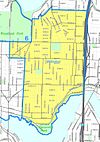
|
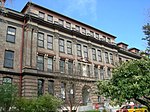
|
[75] Includes historic Latona and usually Tangletown/Meridian (the latter is sometimes considered part of Green Lake)[12][13] |
| 30 | Northlake | Lake Union / Lower Wallingford, spilling over into Fremont and the University District. | 1891[44] | 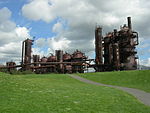
|
|||
| 31 | Green Lake | North Seattle[43] | 1891[44] | 
|
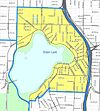
|
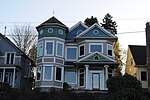
|
[76] Some people consider Meridian / Tangletown to be part of the Green Lake neighborhood.[12][13] |
| 32 | Fremont | North Seattle[43] | 1891[44] | 
|
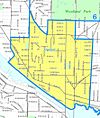
|

|
[77] |
| 33 | Phinney Ridge | North Seattle[43] | 1891[44] | 
|
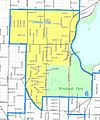
|
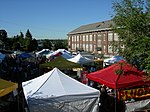
|
[78] |
| 34 | Ballard | North Seattle[43] | 1907[44] | 
|

|

|
[79] |
| 35 | West Woodland | Ballard[79] | 1891 (East of 8th Ave NW), 1907 (West of 8th Ave NW)[44] | 
|
[80] | ||
| 36 | Whittier Heights | Ballard[79] | 1907[44] | 
|
[81] | ||
| 37 | Adams | Ballard[79] | 1907[44] | 
|
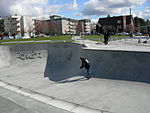
|
[82] | |
| 38 | Sunset Hill | Ballard[79] | 1907[44] | 
|

|
[83] | |
| 39 | Loyal Heights | Ballard[79] | 1907[44] | 
|
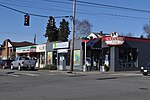
|
[84] | |
| 40 | Central Seattle | Seattle | Various | 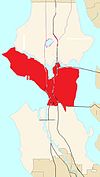
|
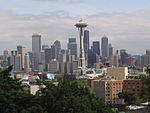
|
Including everything south of the Lake Washington Ship Canal and north of Yesler Way, and some things a bit further south.[43] | |
| 41 | Magnolia | Central Seattle[43] | 1891[44] | 
|
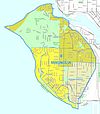
|
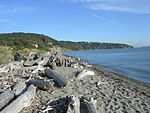
|
[85] |
| 42 | Lawton Park | Magnolia[85] | 1891[44] | 
|
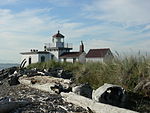
|
[86] | |
| 43 | Briarcliff | Magnolia[85] | 1891[44] | 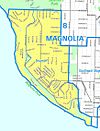
|
[87] | ||
| 44 | Southeast Magnolia | Magnolia[85] | 1891[44] | 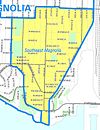
|
[88] | ||
| 45 | Interbay | Central Seattle[43] | 1891[44] | 
|
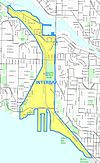
|
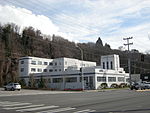
|
[89] |
| 46 | Queen Anne | Central Seattle[43] | [1869], 1883, 1891[44] | 
|

|
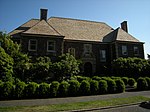
|
[90] Part of Lower Queen Anne was original 1869 Seattle; the area south of McGraw Street was annexed 1883, and the rest 1891.[44] |
| 47 | North Queen Anne | Queen Anne[90] | 1891[44] | 
|

|
[91] | |
| 48 | East Queen Anne | Queen Anne[90] | 1883, 1891[44] | 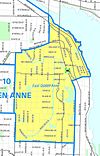
|
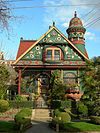
|
[92] Annexed 1883 to McGraw Street, 1891 beyond[44] | |
| 49 | Lower Queen Anne | Queen Anne[90] | [1869], 1883[44] | 
|

|
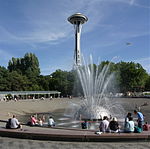
|
[93] Also known as 'Uptown'.[citation needed] |
| 50 | West Queen Anne | Queen Anne[90] | 1883, 1891[44] | 
|
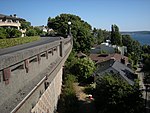
|
[94] | |
| 51 | Capitol Hill | Central Seattle[43] | [1869], 1883, 1891[44] | 
|
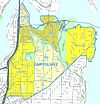
|
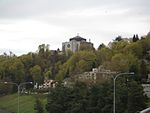
|
[95] 1869: Broadway District was part of "original Seattle" |
| 52 | Portage Bay[96] / Roanoke | Capitol Hill[95] | 1883, 1891[44] | 
|
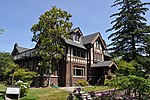
|
[96] Annexed 1883 to E Lynn St, 1891 for the remainder.[44] Includes the Roanoke Park Historic District. | |
| 53 | Broadway | Capitol Hill[95] | [1869][44] | 
|
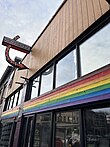 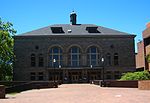
|
[97] The Seattle City Clerk's Neighborhood Atlas map of the Broadway District shown here extends farther to the east and west than most present-day Seattleites would call Broadway. It appears to correspond roughly the portion of Capitol Hill that falls within the original 1869 city limits, and which was known as Broadway before the name Capitol Hill was introduced. | |
| 54 | Pike-Pine Corridor / Pike/Pine[98][99][100] | Capitol Hill / Broadway[95] | [1869][44] | 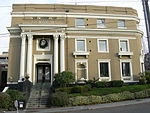
|
The Pike-Pine Corridor, running east-west through what the Seattle City Clerk's Neighborhood Atlas considers the "Broadway" District, has gained a strong identity in the early 21st century. | ||
| 55 | Montlake | Capitol Hill[95] / Central Seattle | 1891,[44] 1950, 1952, 1953 (?)[101] | 
|

|
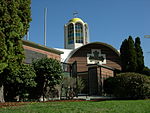
|
[102] The Seattle City Clerk's Neighborhood Atlas classifies Montlake as part of Capitol Hill, but a valley along Boyer Avenue separates it from the hill. |
| 56 | Stevens | Capitol Hill[95] | 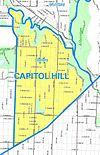
|
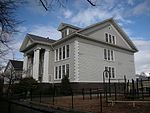
|
[103] The name "Stevens" does not have much currency for most of this area except for the immediate vicinity of the Stevens School at 19th Avenue E and E Galer Street. The small neighborhood just north of that is often called Interlaken, after Interlaken Park; the area centered around 19th Avenue and E Madison Street was known in the early 20th century as Renton Hill, but that name has largely passed out of use. | ||
| 57 | Interlaken | Capitol Hill / Stevens[95] | 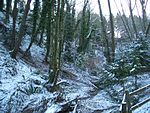
|
Consisting largely of Interlaken Park and Louisa Boren Park, the neighborhood between Capitol Hill proper and Montlake also contains a small number of private homes and the Seattle Hebrew Academy. | |||
| 58 | Madison Valley | Capitol Hill / Stevens[95] / Central Seattle | 1883, 1891[44] | 
|
Annexed 1883 south of E Galer Street, 1891 for the remainder [44] | ||
| 59 | Renton Hill | Capitol Hill / Stevens[95] | 
|
Although the name has largely fallen out of use, the Renton Hill Community Improvement Club, founded June 18, 1901, was Seattle's first community club.[7] | |||
| 60 | Madison Park | Capitol Hill[95] / Central Seattle | 1883, 1891[44] | 
|
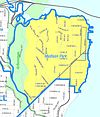
|
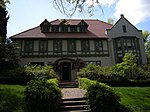
|
[104] Annexed 1883 south of E Galer St; the remainder in 1891.[44] The Seattle City Clerk's Neighborhood Atlas classifies Madison Park as part of Capitol Hill, but a valley through the Washington Park Arboretum separates it from Capitol Hill proper. |
| 61 | Broadmoor | Madison Park | 1883, 1891[44] | 
|
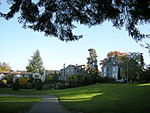
|
Annexed 1883 south of the line of E Galer St; the remainder in 1891.[44] A gated community within Madison Park. | |
| 62 | Lake Union | North Seattle / Central Seattle | 
|
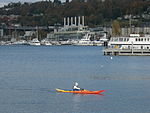
|
The City Clerk's Neighborhood Atlas uses the term "Cascade" to refer to much of the area around Lake Union (see map here), but that use is not at all common. | ||
| 63 | South Lake Union, Seattle | Lake Union | 1883[44] | 
|
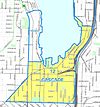
|

|
The City Clerk's Neighborhood Atlas uses the term "Cascade" to refer to much of the area around Lake Union (see image here), but that use is not at all common. |
| 64 | Cascade, Seattle | South Lake Union | 1883[44] | 
|

|
Cascade, south and east of Lake Union originally extended west to Terry Avenue (though it is now generally considered to end at Fairview,[citation needed] south to Denny Hill (now the Denny Regrade) east to Melrose Avenue E (from which it is through the area now cut off by Interstate 5.[105] | |
| 65 | Westlake | Lake Union | 1883[44] | 
|

|
[106] | |
| 66 | Eastlake | Lake Union | 1883, 1891[44] | 
|

|
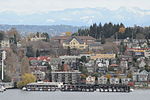
|
[107] |
| 67 | Downtown | Central Seattle | [1869][44] | 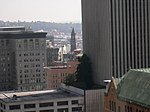
|
[108] | ||
| 68 | Denny Triangle | Downtown[108] | [1869][44] | 
|

|

|
[109] |
| 69 | Belltown | Downtown[108] | [1869][44] | 
|
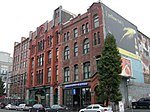
|
[110]
Belltown currently is largely residential with some commercial office buildings, with 1st street containing a large concentration of nightlife dining and drinking establishments. The intersection of 2nd ave and Virginia is the highest point in the Downtown neighbourhood area. | |
| 70 | Pike-Market | Downtown[108] | [1869][44] | 
|
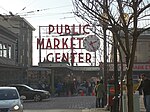
|
[111][112] | |
| 71 | Central Business District | Downtown[108] | [1869][44] | 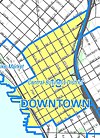
|
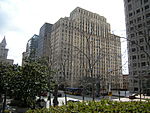
|
[113] | |
| 72 | First Hill | Downtown[108] | [1869][44] | 
|
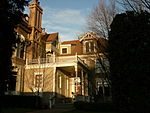
|
[114] Widely known as "Pill Hill" for its many hospitals, this neighborhood immediately east of Downtown was once the city's most desirable residential area. | |
| 73 | Pioneer Square | Downtown[108] | [1869][44] | 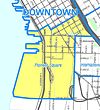
|
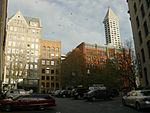
|
[115] The original center of Seattle, the southwest part of present-day Downtown. Probable origin of the term "Skid Road" for a neighborhood. Includes the Pioneer Square-Skid Road Historic District. Pioneer Square as defined by the City Clerk's Neighborhood Atlas also includes the tide lands platted 1895, filled 1902, that are now the site of two professional sports stadiums. | |
| 74 | International District ("ID") | Downtown[108] | [1869][44] | 
|

|
[116] Includes former tide lands platted 1895, filled 1902.[44] Southeast Downtown. Sometimes referred to as "Chinatown", the neighborhood also includes Little Saigon east of Interstate 5, and remnants of the historic Japantown, especially around 6th Avenue and Main Street. | |
| 75 | Yesler Terrace | Downtown[108] | [1869][44] | 
|
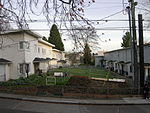
|
[117] Housing project east of Interstate 5; originally, it extended further west into present-day Kobe Terrace Park. | |
| 76 | Central Waterfront | Downtown[108] | [1869][44] | 
|
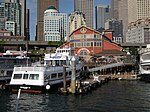
|
[118] | |
| 77 | West Edge[119][120] | Downtown | [1869][44] | 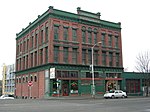
|
The downtown area of both the Central Business District and Belltown from roughly halfway between First and Second Avenues to Alaskan Way (but not including the piers themselves) is sometimes called the Seattle's "West Edge". | ||
| 78 | Central Area[121] / Central District ("CD") | Central Seattle | [1869], 1883[44] | 
|
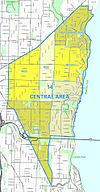
|

|
[121] |
| 79 | Mann | Central Area[121] | [1869][44] | 
|

|
[122] The name Mann for this area around Garfield High School does not have much currency. It comes from the old Horace Mann School, later Nova, just north of Garfield. | |
| 80 | Minor | Central Area[121] | [1869][44] | 
|
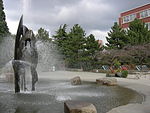
|
[123] The name Minor for this area does not have much currency. It comes from the T.T. Minor School. | |
| 81 | Cherry Hill & Squire Park | Minor | [1869], 1905, 1921[44] | 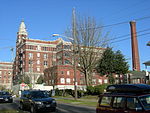
|
Portions are part of original Seattle; Squire Park was annexed in 1905, and a remaining enclave in 1921.[44] | ||
| 82 | Atlantic | Central Area[121] | [1869], 1883[44] | 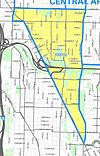
|
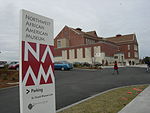
|
[124] The northern portion of this area was part of original 1869 Seattle; south of Atlantic Street was annexed 1883[44] | |
| 83 | Judkins Park | Atlantic | [1869][44] | 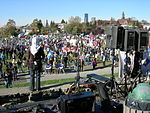
|
[125][126] | ||
| 84 | Madrona | Central Area[121] | [1869], 1883[44] | 
|

|
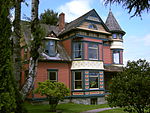
|
[127] South of E Howell Street was original 1869 Seattle; the remainder was annexed 1883.[44] |
| 85 | Madrona Valley | Madrona | [1869][44] | ||||
| 86 | Harrison[121] / Denny-Blaine[121] | Central Area[121] | 1883[44] | 
|
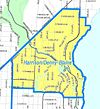
|
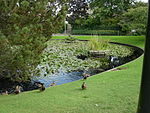
|
[128] |
| 87 | Washington Park | Harrison/Denny-Blaine | 1883[44] | 
|

|
||
| 88 | Leschi[121] | Central Area[121] | [1869][44] | 
|
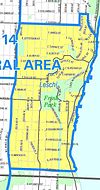
|
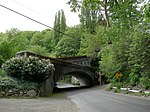
|
[129] |
| 89 | South End | Seattle | various[44] | 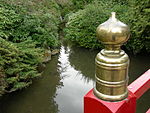
|
[43] | ||
| 90 | Rainier Valley | South End | [1869], 1883, 1907[44] | 
|

|
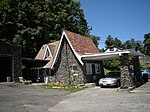
|
[130] North of Atlantic Street was original 1869 Seattle; in 1883, south to Hanford Street was annexed, and the rest in 1907[44] |
| 91 | Mount Baker | Rainier Valley[130] | [1869], 1883, 1907[44] | 
|

|

|
[131] North of Atlantic Street was original 1869 Seattle; in 1883, south to Hanford Street was annexed, and the rest in 1907[44] |
| 92 | Columbia City | Rainier Valley[130] | 1907[44] | 
|

|
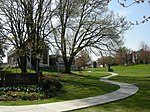
|
[132] A town for 15 years before it was annexed.[133] |
| 93 | Hillman City | Rainier Valley[130] / Columbia City | 1907[44] | South of Columbia City proper,[134][135] | |||
| 94 | Brighton | Rainier Valley[130] | 1907[44] | 
|
[136] The lakeshore next to this neighborhood was once called Brighton Beach, but has since been subsumed into Seward Park in common parlance and according to the Seattle City Clerk's Neighborhood Map Atlas[citation needed] | ||
| 95 | Dunlap / Othello | Rainier Valley[130] | 1907[44][137] | 
|
[138] | ||
| 96 | Rainier Beach / Atlantic City Beach | Rainier Valley[130] | 1907[44] | 
|
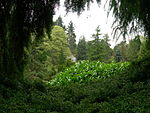
|
[139] | |
| 97 | Rainier View / Lakeridge | Rainier Valley[130] | 1907[44] | 
|

|
[140] | |
| 98 | Seward Park | South End | 1907[44] | 
|
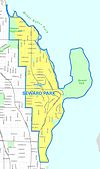
|
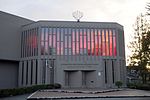
|
[141] |
| 99 | Lakewood | Seward Park | The northern part of the Seward Park neighborhood is sometimes referred to as "Lakewood"; the entire neighborhood also sometimes referred to as "Lakewood/Seward Park". The historic Lakewood Community Club is now called the Lakewood/Seward Park Community Club.[citation needed] | ||||
| 100 | Beacon Hill | South End | [1869], 1875, 1883, 1886, 1907[44] | 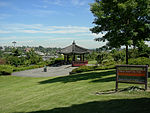
|
[142] | ||
| 101 | North Beacon Hill | Beacon Hill[142] | [1869], 1875, 1883, 1886, 1907[44] | 
|
[143] | ||
| 102 | Mid Beacon Hill (Maplewood) | Beacon Hill[142] | 1907[44] | 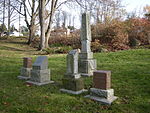
|
[144] | ||
| 103 | Holly Park[145] / NewHolly[146] | Beacon Hill[142] | 1907[44] | 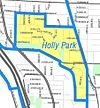
|
[145] Formerly the Holly Park housing project, now officially NewHolly.[146] | ||
| 104 | South Beacon Hill[147] / Van Asselt | Beacon Hill[142] | 1907[44] | [147] | |||
| 105 | Industrial District | South End | various 1895–1910 | 
|

|
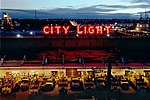
|
[148] Tide lands west of Beacon Hill platted 1895, filled 1902. Other portions annexed 1907 along with West Seattle, Southeast Seattle, and South Park; 1910 with Georgetown.[44] |
| 106 | SoDo | Industrial District[148] | 1895/1902[44] | 
|
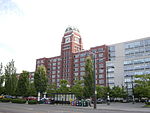
|
Tide lands west of Beacon Hill platted 1895, filled 1902.[44] | |
| 107 | Harbor Island | Industrial District[148] | 1910[44] | 
|

|
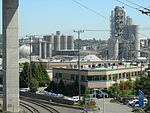
|
[149] |
| 108 | Georgetown | South End | 1910[44] | 
|

|
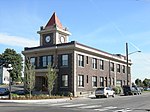
|
[150] A city for 6 years before being annexed in 1910.[44] |
| 109 | South Park | South End | 1907[44] | 
|
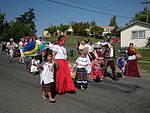
|
[151] A town for 5 years before being annexed in 1907.[44] | |
| 110 | West Seattle | Seattle | 1895/1902, 1907, 1950, 1954, 1956[44][137] | 
|

|
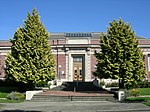
|
[152] Tide lands platted 1895, filled 1902 (although the Seattle City Clerk's Neighborhood Atlas places even the tidelands on the west side of the Duwamish in the Industrial District rather than West Seattle). West Seattle (including portions of Delridge) was a town for 5 years before being annexed in 1907.[44] Some additional annexations 1950, 1954, and 1956, mainly in Arbor Heights.[137] |
| 111 | Alki Point | West Seattle[152] | 1907[44] | 
|
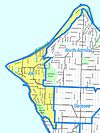
|
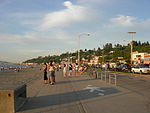
|
[153] |
| 112 | North Admiral[154] / Admiral District | West Seattle[152] | 1907[44] | 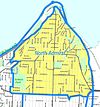
|
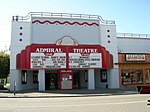
|
[154] | |
| 113 | Junction[155] / West Seattle Junction / Alaska Junction | West Seattle[152] | 1907[44] | 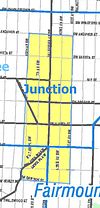
|
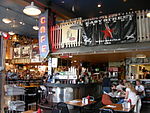
|
[155] Overlaps Genesee. | |
| 114 | Seaview[156] / Mee-Kwa-Mooks | West Seattle[152] | 1907[44] | 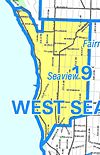
|
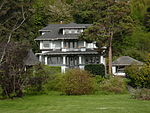
|
[156] | |
| 115 | Fairmount Park | West Seattle[152] | 1907[44] | 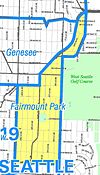
|
[157] | ||
| 116 | Genesee | West Seattle[152] | 1907[44] | 
|
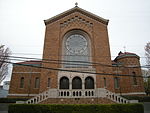
|
[158] Overlaps Junction. | |
| 117 | Gatewood | West Seattle[152] | 1907[44] | 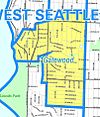
|
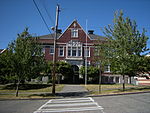
|
[159] | |
| 118 | Fauntleroy | West Seattle[152] | 1907[44] | 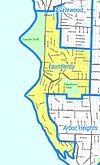
|
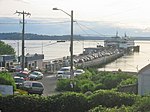
|
[160] | |
| 119 | Arbor Heights | West Seattle[152] | 1907, 1954, 1956[44] | 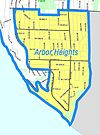
|
[161] | ||
| 120 | Delridge | West Seattle / South End[162] | 1907, 1946, 1949[44] | 
|

|
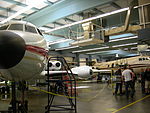
|
[162] Most of Delridge was part of the city of West Seattle, annexed 1907; the remainder was annexed in 1946 and 1949.[44] |
| 121 | North Delridge | Delridge[163] | 1907[44] | 
|
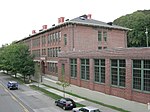
|
[163] | |
| 122 | Pigeon Point | Delridge | 1907[44] | 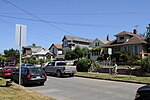
|
The extreme northeast portion of Delridge, east of Delridge Way and north of Puget Park.[164] | ||
| 123 | Riverview | Delridge[165] | 1907[44] | 
|
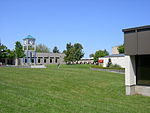
|
[165] | |
| 124 | Highland Park | Delridge[166] | 1907[44] | 
|
[166] | ||
| 125 | South Delridge | Delridge[167] | 1907, 1946, 1949[44] | 
|
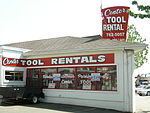
|
[167] | |
| 126 | Roxhill | Delridge[168] | 1907[44] | 
|
[168] | ||
| 127 | High Point | Delridge[169] | 1907[44] | 
|

|
[169] |
Annexations
[edit]Seattle annexed eight municipalities between 1905 and 1910, nearly doubling the area size of the city. Annexations by law were begun by the annexee and had to be approved by the Seattle City Council. The appeal of the inexpensive and accessible electric power and water system services of the public utilities were the primary motivations for the annexation movements.
Ballard was its own incorporated town for 17 years, annexed as its own ward. West Seattle incorporated in 1902, then annexed Spring Hill, Riverside, Alki Point, and Youngstown districts. It was the largest of the incorporated towns to be annexed. Southeast Seattle merged the towns of Hillman City and York with other Rainier Valley neighborhoods, then incorporated for the only reason of being annexed.[170] Similarly, the town of South Seattle consisted of mostly industrial Duwamish Valley neighborhoods (except Georgetown); one enclave adjacent to Georgetown omitted at this time was annexed 1921; some land near the river in this area remains part of unincorporated King County. In 1910 Georgetown was the last of this sequence of small incorporated cities and towns to be annexed to Seattle before the 1954 annexation of Lake City.
The following previously incorporated cities and towns were annexed by Seattle. This list is in order of annexation. Other areas annexed to Seattle, were unincorporated before annexation. Examples of the latter include the northern part of Queen Anne Hill, the University District, and the northern area of the city that were once part of then-unincorporated Shoreline.
- Town of South Seattle, incorporated 1905, annexed 20 October 1905.
- City of Columbia (Columbia City), incorporated 1892, annexed 3 May 1907
- Town of Ravenna, incorporated 1906, annexed 15 January 1907
- Southeast Seattle—Hillman City, York, and other Rainier Valley neighborhoods except Columbia City—incorporated July 1906, annexed 7 January 1907
- Town of South Park, incorporated 1902, annexed 3 May 1907.
- City of Ballard, incorporated January 1890, annexed 29 May 1907
- City of West Seattle, incorporated April 1902, annexed 24 July 1907
- City of Georgetown, incorporated 1904, annexed 4 April 1910[137][171]
- Lake City, incorporated township 1949, annexed January 1954[11]
Future
[edit]This section needs additional citations for verification. (May 2009) |
Because of the cost of providing city services, low-density residential neighborhoods represent a net revenue loss for municipalities.[172] Because vehicle-license revenue is no longer used to subsidize unincorporated areas, these neighborhoods have become increasingly orphaned.[citation needed]
In April 2004, the City Council voted to defer a decision on Mayor Nickels' proposal to designate the West Hill and North Highline neighborhoods, part of unincorporated King County, as potential annexation areas (PAAs) for at least a year.[173] Because of the tax revolt that took place in Washington in the late 1990s and early 21st century, the county's budget has been reduced and the county has said it is unlikely to be able to maintain adequate levels of funding for urban services in unincorporated areas. The nearby city of Burien, however, issued a 2004 draft report for its own annexation of all or part of North Highline.
North Highline, which adjoins SeaTac, Burien, and Tukwila in addition to Seattle, consists of the Boulevard Park neighborhood and part of White Center. West Hill, which abuts Tukwila and Renton as well as Seattle, consists of Bryn Mawr-Skyway, Lakeridge, and Earlington. Its 2010 population is 15,645.
On December 11, 2006, the Seattle City Council agreed to designate North Highline a "potential annexation area".[174]
See also
[edit]- Street layout of Seattle about transportation and street naming
- 110th Cascades SEA Street regarding a structure helping define a neighborhood
Notes and references
[edit]- ^ Greg Nickels (July 2005). "Nickels Newsletter – July 2005". Archived from the original on October 25, 2006. Retrieved October 11, 2007.
- ^ There is a book about Seattle by Arthur J O'Donnell, In the City of Neighborhoods, iUniverse, Inc., 2004), ISBN 0-595-33792-9.
- ^ a b Jack Broom (October 5, 2002). "New Seattle map: There goes the neighborhood". Seattle Times. Archived from the original on May 19, 2007. Retrieved October 11, 2007.
- ^ Phelps, p. 34; Chapter 16, "Street Names and House Numbering", pp. 225-235; Chapter 15, "Annexation", pp. 216–224, map "to 1921", p. 217; map "to 1975", p. 224, map key table pp.222-3.
- ^ Speidel, William C. (1978). Doc Maynard: the man who invented Seattle. Seattle: Nettle Creek Publishing Company. pp. 196–197, 200. ISBN 0-914890-02-6.. Speidel, William C. (1967). Sons of the profits; or, There's no business like grow business: the Seattle story, 1851-1901. Seattle: Nettle Creek Publishing Company. pp. 196–197, 200. ISBN 0-914890-06-9.
- ^ Wilma, David (May 21, 2001). "Seattle Landmarks: West Queen Anne Walls (1913)". HistoryLink.org Essay 3198. Retrieved April 21, 2006.
Cf. "West Queen Anne Walls, 'W'". Historic Preservation :: Department of Neighborhoods > Individual Landmarks & the Designation Process > Landmarks A-Z. May 21, 2006. Retrieved April 21, 2006. - ^ a b Wilma, David (April 1, 2001). "Renton Hill residents organize Seattle's first community club on June 18, 1901". HistoryLink.org Essay 3157. Retrieved April 21, 2006.
- ^ Wilma, David (April 1, 2001). "Renton Hill Community Club reorganizes to exclude racial minorities from the neighborhood in 1929". HistoryLink.org Essay 3158. Retrieved April 21, 2006.
- ^ Wilma, David (July 5, 2002). "Magnolia Branch, The Seattle Public Library". HistoryLink.org Essay 3879. Retrieved April 21, 2006.
- ^ David Wilma (October 8, 2002). "Greenwood Branch, The Seattle Public Library – HistoryLink.org Essay 3980". HistoryLink.org Online Encyclopedia of Washington State History. Retrieved May 6, 2009.
- ^ a b Wilma, David (December 5, 2002). "Lake City Branch, The Seattle Public Library". HistoryLink.org Essay 4031. Retrieved April 21, 2006.
- ^ a b c d e Dorpat, Paul (July 24, 2001). "Seattle Neighborhoods: Wallingford -- Thumbnail History". HistoryLink Essays. HistoryLink.org. Retrieved July 30, 2006.
- ^ a b c d Dorpat, Paul (1984). "42, 58, 64 (Fremont); 36, 37, 42, 64, 71 (Latona); 36, 37, 42, 71 (University)". Seattle, now & then. Seattle: Tartu Publications. ISBN 0-9614357-0-4.
1984, 2nd ed. 1994
- ^ Dorpat, Paul (1986). "52". Seattle, now & then, volume II. Seattle: Tartu Publications. ISBN 0-9614357-2-0.
- ^ Wilma (20 August 2001, Essay 3502)
- ^ Williams, David B. (May 10, 1999). "Olmsted Parks in Seattle -- A Snapshot History". HistoryLink.org Essay 1124. Retrieved April 21, 2006.
- ^ "Lake Union". Seattle Neighborhoods. n.d. Archived from the original on February 24, 2006. Retrieved May 21, 2006.
- ^ Hatt, Schmid, Nobbe, & Mitchell
- ^ a b Gregory, James (2004–2011). "Segregated Seattle". Seattle Civil Rights and Labor History Project. The University of Washington. Retrieved April 18, 2011.
- ^ Turnbull, Lornet (June 3, 2005). "Homeowners find records still hold blot of racism". Local News. The Seattle Times. pp. B1–. Archived from the original on May 17, 2006. Retrieved May 21, 2006.
- ^ a b Wilma, David (May 1, 2002). "Seattle voters reject a city manager and district elections on June 30, 1914". HistoryLink.org Essay 3761. Retrieved May 4, 2009.
- ^ Wilma, David (May 11, 2002). "Seattle voters reject district city council elections and Rich Man's Charter on November 2, 1926". HistoryLink.org Essay 3768. Retrieved May 4, 2009.
- ^ Kit Oldham & David Wilma (September 7, 2006). "Washington voters reject property rights, casino gambling, and other ballot measures on November 7, 1995". HistoryLink.org Essay 7916. Retrieved May 4, 2009.
- ^ Matt Rosenberg (June 15, 2005). "Red in a Blue City: Seattle Republicans". Seattle Weekly. Retrieved April 19, 2011.
- ^ Jake Batsell; Jack Broom; Barbara A. Serrano (March 18, 1998). "Stewart Case: $5 Million Fine". Seattle Times. Retrieved May 4, 2009.
- ^ a b Walt Crowley (May 9, 2001). "Seattle's Little City Halls". HistoryLink.org. Retrieved April 27, 2009.
- ^ Neighborhood Service Centers Archived April 27, 2011, at the Wayback Machine, City of Seattle. Retrieved April 17, 2011.
- ^ Phelps, pp. 82–84
- ^ Wilma, David (March 20, 2006). "Seattle voters reject district elections for city council on November 7, 1995". HistoryLink.org Essay 4246. Archived from the original on October 28, 2007. Retrieved April 21, 2006.
- ^ Maria Christensen, Newcomer's Handbook for Moving to and Living in Seattle: Including Bellevue, Redmond, Everett, and Tacoma, Newcomer's Handbooks, First Books, 2007, ISBN 0-912301-73-2. p. 17. "Unlike many other major cities, Seattle neighborhoods do not have official borders."
- ^ Maple Leaf: Neighborhood is another one of Seattle's best-kept secrets [dead link]
- ^ MLCC – Neighborhood Map
- ^ ""Maple Leaf", map". Seattle City Clerk's Neighborhood Map Atlas. June 17, 2002. Retrieved April 27, 2009.
- ^ American Association of State Highway and Transportation Officials (AASHTO) standards for urban areas having more than 50,000 people
- ^ (1)
"Planned Arterials Map Legend Definitions" (PDF). Street Classification Maps. Seattle Department of Transportation. January 2, 2004. Archived from the original (PDF) on January 17, 2006. Retrieved April 21, 2006.
(2) "Street Classification Maps". Seattle Department of Transportation. 2005. Archived from the original on June 14, 2006. Retrieved April 21, 2006.
High-Resolution Version Archived September 24, 2015, at the Wayback Machine, PDF format, 16.1 MB
Medium-Resolution Version Archived March 2, 2016, at the Wayback Machine, PDF format, 1.45 MB 12 January 2004.
Low-Resolution Version Archived June 22, 2006, at the Wayback Machine, PDF format, 825 KB 12 January 2004.
"Planned Arterials Map Legend Definitions" Archived January 17, 2006, at the Wayback Machine, PDF format. 12 January 2004.
The high resolution version is good for printing, 11 x 17. The low and medium resolution versions are good for quicker online viewing. (Source: "Street Classification Maps, Note on Accessing These PDF Files". Archived June 14, 2006, at the Wayback Machine ) - ^ "Street Classification Maps, Note on Accessing These PDF Files". Street Classification Maps. Seattle Department of Transportation. 2005. Archived from the original on June 14, 2006. Retrieved April 21, 2006.
- ^ "Historic Districts". Seattle Department of Neighborhods. Retrieved September 7, 2021.
- ^ Other well-documented interpretations of names and boundaries of Seattle's neighborhoods can be found in the following:
- "Seattle Neighborhoods" from the HistoryLink Encyclopedia of Washington State History (particularly their "Thumbnail Histories", many of which reference records of neighborhood organizations and public library branches).
- Myra Phelps, A Narrative History (a history of Seattle through Engineering Department records and notes).
- The "Neighbors"[dead link] project of the Seattle Post-Intelligencer (1996-2000), currently updated as the "Webtowns" section of the online Post-Intelligencer.
- Neighborhood articles in the archives of the Post-Intelligencer,[1] The Times, and local district newspapers. (Post-Intelligencer archives before 1986 are not available online. The Seattle Times archives before 1990 are not available online.)
- "Street Classification Maps" Archived June 14, 2006, at the Wayback Machine from the Seattle Department of Transportation. The Transportation Department has built and designated secondary arterials (officially called minor arterials) predominantly along neighborhood boundaries."The Free Online Encyclopedia of Washington State History". Archived from the original on February 6, 2016. Retrieved May 31, 2006.
- ^ "List of Neighborhoods". Seattle City Clerk's Neighborhood Map Atlas. Retrieved April 29, 2009.
Shenk, Pollack, Dornfeld, Frantilla, and Neman (authors of the Seattle Atlas) drew largely upon primary sources. Phelps is also a high quality secondary source, since much of her sources were Department archives of official documents and reports, in addition to professional journal articles, as well as books and articles back to the early 20th century. Phelps and Shenk et al. have complete citations in this article's Bibliography.
The Seattle City Clerk's Neighborhood Map Atlas was "not designed or intended as an 'official' City of Seattle neighborhood map ... [but] to define neighborhood district names and boundaries in a way that improves document indexing and retrieval." As such, some of its designations have no existence outside of the city's map and indexing system, such as Pike Market (Pike Place Market in actuality), Mann, Minor, and Mid Beacon Hill. In addition, the map's attempt to reduce the number of top-level districts has led to certain discrepancies from facts on the ground, such as Harrison/Denny-Blaine being included in the Central District and Madison Park being included in Capitol Hill. - ^ Cline, Scott, City Archivist (2006). "Department of Community Development (1600) (second edition)". "Seattle Municipal Archives Record Descriptions", A Guide To The Archives Of The City Of Seattle. Retrieved April 21, 2006.
{{cite web}}: CS1 maint: multiple names: authors list (link) - ^ The Seattle Post-Intelligencer's "Neighborhood Profiles" are not available online. The concept has been revisited 1996-2000 as the "Neighbors" [dead link] project, currently updated as the "Webtowns" section.
- ^ [1869] means part of Seattle as incorporation, December 1869. Otherwise, year listed is actual annexation, not the date of the prerequisite enabling city ordinance.
The State Legislature incorporated the town of Seattle in January 1865, disincorporated January 1867 after petition, reincorporated December 1869. The initial incorporation was with a board of trustees. The second incorporation was with a mayor and town council. Lange, Greg; Tate, Cassandra (November 4, 1998). "Legislature incorporates the Town of Seattle for the first time on January 14, 1865". HistoryLink.org Essay 168. Retrieved April 21, 2006. - ^ a b c d e f g h i j k l m n o p q r s t u v w x y z aa ab ac ad (Map breaking city into three major areas) and NN 1000 Neighborhood districts (a list of districts), Seattle City Clerk's Neighborhood Atlas. Retrieved April 24, 2011.
- ^ a b c d e f g h i j k l m n o p q r s t u v w x y z aa ab ac ad ae af ag ah ai aj ak al am an ao ap aq ar as at au av aw ax ay az ba bb bc bd be bf bg bh bi bj bk bl bm bn bo bp bq br bs bt bu bv bw bx by bz ca cb cc cd ce cf cg ch ci cj ck cl cm cn co cp cq cr cs ct cu cv cw cx cy cz da db dc dd de df dg dh di dj dk dl dm dn do dp dq dr ds dt du dv dw dx dy dz ea eb ec ed ee ef eg eh ei ej Phelps
- ^ Broadview, Seattle City Clerk's Neighborhood Atlas. Retrieved April 24, 2011.
- ^ Bitter Lake (neighborhood), Seattle City Clerk's Neighborhood Atlas. Retrieved April 24, 2011.
- ^ North Beach/Blue Ridge, Seattle City Clerk's Neighborhood Atlas. Retrieved April 24, 2011.
- ^ Parts of Crown Hill annexed 1907 as part of Ballard
- ^ Crown Hill, Seattle City Clerk's Neighborhood Atlas. Retrieved April 24, 2011.
- ^ Greenwood, Seattle City Clerk's Neighborhood Atlas. Retrieved April 24, 2011.
- ^ a b c d e Northgate, Seattle City Clerk's Neighborhood Atlas. Retrieved April 24, 2011.
- ^ Haller Lake, Seattle City Clerk's Neighborhood Atlas. Retrieved April 24, 2011.
- ^ Pinehurst, Seattle City Clerk's Neighborhood Atlas. Retrieved April 24, 2011.
- ^ North College Park, Seattle City Clerk's Neighborhood Atlas. Retrieved April 24, 2011.
- ^ Maple Leaf, Seattle City Clerk's Neighborhood Atlas. Retrieved April 24, 2011.
- ^ a b c d e f Lake City, Seattle City Clerk's Neighborhood Atlas. Retrieved April 24, 2011.
- ^ Cedar Park, Seattle City Clerk's Neighborhood Atlas. Retrieved April 24, 2011.
- ^ Matthews Beach, Seattle City Clerk's Neighborhood Atlas. Retrieved April 24, 2011.
- ^ Meadowbrook, Seattle City Clerk's Neighborhood Atlas. Retrieved April 24, 2011.
- ^ Olympic Hills, Seattle City Clerk's Neighborhood Atlas. Retrieved April 24, 2011.
- ^ Victory Heights, Seattle City Clerk's Neighborhood Atlas. Retrieved April 24, 2011.
- ^ Wedgwood, Seattle City Clerk's Neighborhood Atlas. Retrieved April 24, 2011.
- ^ View Ridge, Seattle City Clerk's Neighborhood Atlas. Retrieved April 24, 2011.
- ^ Sand Point, Seattle City Clerk's Neighborhood Atlas. Retrieved April 24, 2011.
- ^ Roosevelt, Seattle City Clerk's Neighborhood Atlas. Retrieved April 24, 2011.
- ^ a b Ravenna, Seattle City Clerk's Neighborhood Atlas. Retrieved April 24, 2011.
- ^ Bryant, Seattle City Clerk's Neighborhood Atlas. Retrieved April 24, 2011.
- ^ Windermere, Seattle City Clerk's Neighborhood Atlas. Retrieved April 24, 2011.
- ^ Laurelhurst, Seattle City Clerk's Neighborhood Atlas. Retrieved April 24, 2011.
- ^ Windermere, Seattle City Clerk's Neighborhood Atlas. Retrieved April 24, 2011.
- ^ Souvenir guide of the Alaska-Yukon-Pacific Exposition – held at Seattle, Washington, June 1st to October (Seattle 1909), p.11. Image online.
- ^ "Northeast Campus Map". UW Home > UWIN > About the UW > Campus Maps. University of Washington Computing and Communications, Facilities Services. May 5, 2010. Retrieved April 18, 2011.
- ^ Publication Services & UW Facility Services (July 1996). The University of Washington Campus & Vicinity (map). Seattle: University of Washington.
- ^ University of Washington Publication Services (September 1991). The University of Washington Campus & Vicinity (map). Seattle: University of Washington. Compiled, designed, drafted in cooperation between Physical Plant and the Department of Geography, August 1971, revised Sherman (August 1991).
- ^ Wallingford, Seattle City Clerk's Neighborhood Atlas. Retrieved April 24, 2011.
- ^ Green Lake, Seattle City Clerk's Neighborhood Atlas. Retrieved April 24, 2011.
- ^ Fremont, Seattle City Clerk's Neighborhood Atlas.
- ^ Phinney Ridge, Seattle City Clerk's Neighborhood Atlas.
- ^ a b c d e f Ballard, Seattle City Clerk's Neighborhood Atlas.
- ^ West Woodland, Seattle City Clerk's Neighborhood Atlas.
- ^ Whittier Heights, Seattle City Clerk's Neighborhood Atlas.
- ^ Adams, Seattle City Clerk's Neighborhood Atlas.
- ^ Sunset Hill, Seattle City Clerk's Neighborhood Atlas.
- ^ Loyal Heights, Seattle City Clerk's Neighborhood Atlas.
- ^ a b c d Magnolia, Seattle City Clerk's Neighborhood Atlas.
- ^ Lawton Park, Seattle City Clerk's Neighborhood Atlas.
- ^ Briarcliff, Seattle City Clerk's Neighborhood Atlas.
- ^ Southeast Magnolia, Seattle City Clerk's Neighborhood Atlas.
- ^ Interbay, Seattle City Clerk's Neighborhood Atlas.
- ^ a b c d e Queen Anne, Seattle City Clerk's Neighborhood Atlas.
- ^ North Queen Anne, Seattle City Clerk's Neighborhood Atlas.
- ^ East Queen Anne, Seattle City Clerk's Neighborhood Atlas.
- ^ Lower Queen Anne, Seattle City Clerk's Neighborhood Atlas.
- ^ West Queen Anne, Seattle City Clerk's Neighborhood Atlas.
- ^ a b c d e f g h i j Capitol Hill, Seattle City Clerk's Neighborhood Atlas.
- ^ a b Portage Bay, Seattle City Clerk's Neighborhood Atlas.
- ^ Broadway, Seattle City Clerk's Neighborhood Atlas.
- ^ Tyrone Beason, Seattle's Pike/Pine corridor does density right, Seattle Times, January 23, 2010, corrected February 19, 2010. Retrieved June 15, 2011.
- ^ Pike/Pine: Cars, Bars, and Dead Rock Stars Archived June 18, 2011, at the Wayback Machine, Seattle Architecture Foundation. Retrieved June 17, 2011.
- ^ Erica C. Barnett, The Death of Pike/Pine, The Stranger, November 29, 2006. Retrieved June 17, 2011.
- ^ A somewhat cryptic older note here says "1891, E of 15th, N of E Galer, N of E Lynn, 1891, Phelps. 1950, 1952, 1953.[citation needed] This needs clarification: This would have the farthest part of Montlake from the city center annexed in 1891, and the rest more than half a century later.
- ^ Montlake, Seattle City Clerk's Neighborhood Atlas.
- ^ Stevens, Seattle City Clerk's Neighborhood Atlas.
- ^ Portage Bay, Seattle City Clerk's Neighborhood Atlas.
- ^ History, Organizational Description, Boundaries, Cascade Neighborhood Council, November 1997. Accessed 3 February 2008.
- ^ Westlake, Seattle City Clerk's Neighborhood Atlas.
- ^ Eastlake, Seattle City Clerk's Neighborhood Atlas.
- ^ a b c d e f g h i j Downtown, Seattle City Clerk's Neighborhood Atlas.
- ^ Denny Regrade, Seattle City Clerk's Neighborhood Atlas.
- ^ Belltown, Seattle City Clerk's Neighborhood Atlas.
- ^ Pike-Market, Seattle City Clerk's Neighborhood Atlas.
- ^ The 17-acre (6.9 ha) Pike Market neighborhood is nearly twice the area of the 9-acre (3.6 ha) Pike Place Market Historic District.
(1) Lange, Greg (January 1, 1999). "Seattle's Pike Place Market opens on August 17, 1907". HistoryLink.org Essay 1949. Retrieved July 21, 2006.lead paragraph updated 2006
(2) Crowley, Walt (July 29, 1999). "Pike Place Market (Seattle) -- Thumbnail History". HistoryLink.org Essay 1602. Retrieved July 21, 2006. - ^ Central Business District, Seattle City Clerk's Neighborhood Atlas.
- ^ First Hill, Seattle City Clerk's Neighborhood Atlas.
- ^ Pioneer Square, Seattle City Clerk's Neighborhood Atlas. Retrieved May 11, 2011.
- ^ International District, Seattle City Clerk's Neighborhood Atlas. Retrieved May 11, 2011.
- ^ Yesler Terrace, Seattle City Clerk's Neighborhood Atlas. Retrieved May 11, 2011.
- ^ Central Waterfront, Seattle City Clerk's Neighborhood Atlas. Retrieved May 11, 2011.
- ^ seattlewestedge.org home page, Metropolitan Improvement District. Retrieved June 17, 2011.
- ^ So that would make downtown East West Edge?, Puget Sound Business Journal, July 15, 2001. Retrieved June 17, 2011.
- ^ a b c d e f g h i j k Central Area, Seattle City Clerk's Neighborhood Atlas. Retrieved May 11, 2011.
- ^ Mann, Seattle City Clerk's Neighborhood Atlas. Retrieved May 11, 2011.
- ^ Minor, Seattle City Clerk's Neighborhood Atlas. Retrieved May 11, 2011.
- ^ Atlantic, Seattle City Clerk's Neighborhood Atlas. Retrieved May 11, 2011.
- ^ Merritt, Mike; Goldsmith, Steven (July 13, 1994). "The neighborhood that time forgot". Neighbors, History and background on Judkins Park, Neighbors project. Seattle Post-Intelligencer. Retrieved April 21, 2006. [dead link]
- ^ Judkins Foundation (February 9, 1999). "Where is Judkins Park?". Judkins Park Review. City of Seattle. Archived from the original on March 23, 2006. Retrieved April 21, 2006.
- ^ Madrona, Seattle City Clerk's Neighborhood Atlas. Retrieved May 11, 2011.
- ^ Harrison & Denny-Blaine, Seattle City Clerk's Neighborhood Atlas. Retrieved May 11, 2011.
- ^ Leschi, Seattle City Clerk's Neighborhood Atlas. Retrieved May 11, 2011.
- ^ a b c d e f g h Rainier Valley, Seattle City Clerk's Neighborhood Atlas. Retrieved May 11, 2011.
- ^ Mount Baker, Seattle City Clerk's Neighborhood Atlas. Retrieved May 11, 2011.
- ^ Columbia City, Seattle City Clerk's Neighborhood Atlas. Retrieved May 11, 2011.
- ^ Several articles about Columbia City (and other places in the Rainier Valley) can be found at Articles, Rainier Valley Historical Society.
- ^ http://www.hillmancitybiz.org Archived April 23, 2008, at the Wayback Machine. Possibly dead link April 2011; a backup can be found at https://web.archive.org/web/20080703172423/http://www.hillmancitybiz.org/sitemap
- ^ Neighborhood Plans: Columbia City / Hillman City Archived January 20, 2012, at the Wayback Machine, Seattle Department of Neighborhoods. Retrieved May 11, 2011.
- ^ Brighton, Seattle City Clerk's Neighborhood Atlas. Retrieved May 11, 2011.
- ^ a b c d Cline, Scott, City Archivist (2006). "Annexed Cities (9100)". "Seattle Municipal Archives Record Descriptions", A Guide To The Archives Of The City Of Seattle, second edition. Office of the Seattle City Clerk. Archived from the original on September 26, 2007. Retrieved April 21, 2006.
{{cite web}}: CS1 maint: multiple names: authors list (link) - ^ Dunlap, Seattle City Clerk's Neighborhood Atlas. Retrieved May 12, 2011.
- ^ Rainier Beach, Seattle City Clerk's Neighborhood Atlas. Retrieved May 12, 2011.
- ^ Rainier View, Seattle City Clerk's Neighborhood Atlas. Retrieved May 12, 2011.
- ^ Seward Park, Seattle City Clerk's Neighborhood Atlas. Retrieved May 12, 2011.
- ^ a b c d e Beacon Hill, Seattle City Clerk's Neighborhood Atlas. Retrieved May 12, 2011.
- ^ North Beacon Hill, Seattle City Clerk's Neighborhood Atlas. Retrieved May 13, 2011.
- ^ Mid Beacon Hill, Seattle City Clerk's Neighborhood Atlas. Retrieved May 13, 2011.
- ^ a b Holly Park, Seattle City Clerk's Neighborhood Atlas. Retrieved May 13, 2011.
- ^ a b (Untitled page), NewHolly community section of seattlehousing.org (SHA). Retrieved May 13, 2011.
- ^ a b South Beacon Hill, Seattle City Clerk's Neighborhood Atlas. Retrieved May 13, 2011.
- ^ a b c Industrial District, Seattle City Clerk's Neighborhood Atlas. Retrieved May 13, 2011.
- ^ Harbor Island, Seattle City Clerk's Neighborhood Atlas. Retrieved May 13, 2011.
- ^ Georgetown, Seattle City Clerk's Neighborhood Atlas. Retrieved May 14, 2011.
- ^ South Park, Seattle City Clerk's Neighborhood Atlas. Retrieved May 14, 2011.
- ^ a b c d e f g h i j West Seattle, Seattle City Clerk's Neighborhood Atlas. Retrieved May 14, 2011.
- ^ Alki, Seattle City Clerk's Neighborhood Atlas. Retrieved May 13, 2011.
- ^ a b North Admiral, Seattle City Clerk's Neighborhood Atlas. Retrieved May 13, 2011.
- ^ a b North Admiral, Seattle City Clerk's Neighborhood Atlas. Retrieved May 13, 2011.
- ^ a b Seaview, Seattle City Clerk's Neighborhood Atlas. Retrieved May 13, 2011.
- ^ Fairmount Park, Seattle City Clerk's Neighborhood Atlas. Retrieved May 13, 2011.
- ^ Genesee, Seattle City Clerk's Neighborhood Atlas. Retrieved May 13, 2011.
- ^ Gatewood, Seattle City Clerk's Neighborhood Atlas. Retrieved May 13, 2011.
- ^ Fauntleroy, Seattle City Clerk's Neighborhood Atlas. Retrieved May 13, 2011.
- ^ Arbor Heights, Seattle City Clerk's Neighborhood Atlas. Retrieved May 13, 2011.
- ^ a b Delridge, Seattle City Clerk's Neighborhood Atlas. Retrieved May 14, 2011.
- ^ a b North Delridge, Seattle City Clerk's Neighborhood Atlas. Retrieved May 14, 2011.
- ^ Who We Are, pigeonpoint.org (Pigeon Point Neighborhood Council). Retrieved May 15, 2011.
- ^ a b Riverview, Seattle City Clerk's Neighborhood Atlas. Retrieved May 14, 2011.
- ^ a b Highland Park, Seattle City Clerk's Neighborhood Atlas. Retrieved May 14, 2011.
- ^ a b South Delridge, Seattle City Clerk's Neighborhood Atlas. Retrieved May 15, 2011.
- ^ a b Roxhill, Seattle City Clerk's Neighborhood Atlas. Retrieved May 15, 2011.
- ^ a b High Point, Seattle City Clerk's Neighborhood Atlas. Retrieved May 15, 2011.
- ^ Rainier Valley neighborhoods south of Hanford Street to Rainier Beach at Kenyon Street, generally east of 24th Avenue S. - Phelps, pp. 216–218, 222–224
- ^ Phelps, pp. 216-218, 222-224
- ^ Phelps, pp. 216-224
- ^ "Newswatch". The Seattle Times. April 6, 2004. p. B4.
- ^ Galloway, Angela (December 12, 2006). "City Council to pursue annexing North Highline". Hearst Seattle Media, LLC.
Bibliography
[edit]- "About the Seattle City Clerk's Online Information Services". Information Services. Seattle City Clerk's Office. April 30, 2006. Retrieved May 21, 2006.
See heading, "Note about limitations of these data". - "Ballard". Seattle City Clerk's Neighborhood Map Atlas. June 13–17, 2002. Retrieved April 21, 2006.
Maps "NN-1120S", "NN-1130S", "NN-1140S".Jpg [sic] dated 13 June; "NN-1030S", "NN-1040S".jpg dated 17 June 2002. - "Downtown". Seattle City Clerk's Neighborhood Map Atlas. June 13–17, 2002. Retrieved April 21, 2006.
Maps "NN-1120S", "NN-1130S", "NN-1140S".Jpg [sic] dated 13 June; "NN-1030S", "NN-1040S".jpg dated 17 June 2002. - "Map home". Seattle City Clerk's Neighborhood Map Atlas. June 13–17, 2002. Retrieved April 21, 2006.
Full city map, not titled.
Maps "NN-1120S", "NN-1130S", "NN-1140S".Jpg [sic] dated 13 June; "NN-1030S", "NN-1040S".jpg dated 17 June 2002. - "Lake City". Seattle City Clerk's Neighborhood Map Atlas. Office of the Seattle City Clerk. June 17, 2002. Retrieved April 21, 2006.
- "Neighborhood Resources". Department of Neighborhoods. City of Seattle. 2005. Archived from the original on February 23, 2006. Retrieved April 21, 2006.
- "List of Neighborhoods". Seattle City Clerk's Neighborhood Map Atlas. Retrieved April 21, 2006.
Hierarchical list of neighborhoods by districts, largely in geographical order from north to south. - "Northgate". Seattle City Clerk's Neighborhood Map Atlas. Office of the Seattle City Clerk. June 17, 2002. Retrieved April 21, 2006.
- "PDF Note". Principal, Minor and Collector arterials. Seattle Department of Transportation. 2005. Archived from the original on June 14, 2006. Retrieved April 21, 2006.
- Phelps, Myra L. (1978). Public works in Seattle. Seattle: Seattle Engineering Department. ISBN 0-9601928-1-6.
- "Seattle Interactive Map". Seattle Neighborhoods. HistoryLink.org. Archived from the original on February 24, 2006. Retrieved April 21, 2006.
- "Rainier Valley, map". Seattle City Clerk's Neighborhood Map Atlas. Office of the Seattle City Clerk. June 13–17, 2002. Retrieved April 21, 2006.
Maps "NN-1030S", "NN-1040S".jpg 17 June 2002, maps "NN-1120S", "NN-1130S", "NN-1140S".Jpg [sic] 13 June. - Shenk, Carol; Pollack, Laurie; Dornfeld, Ernie; Frantilla, Anne; Neman, Chris (June 26, 2002). "About neighborhood maps". Seattle City Clerk's Office Neighborhood Map Atlas. Information Services, Seattle City Clerk's Office. Retrieved April 21, 2006.
Sources for this atlas and the neighborhood names used in it include a 1980 neighborhood map produced by the Department of Community Development (relocated to the Department of Neighborhoods Archived February 23, 2006, at the Wayback Machine and other agencies), Seattle Public Library indexes (Special Collections, Seattle Collection in the Seattle Room), a 1984-1986 Neighborhood Profiles feature series in the Seattle Post-Intelligencer, numerous parks, land use and transportation planning studies, and records in the Seattle Municipal Archives.
[Maps "NN-1120S", "NN-1130S", "NN-1140S".Jpg [sic] dated 13 June 2002; "NN-1030S", "NN-1040S".jpg dated 17 June 2002.]
"The Neighbors [dead link] project was published weekly in the Seattle Post-Intelligencer from 1996 to 2000. The page remained available for archival purposes for some years after being superseded by the P-I's Webtowns section. - Wilma, David (July 18, 2001). "Seattle Neighborhoods: Lake City -- Thumbnail History". HistoryLink.org Essay 3449. Retrieved April 21, 2006.
- "Webtowns". Seattle Post-Intelligencer. Retrieved April 21, 2006.
Further reading
[edit]- Detailed city map, Seattle City Clerk's Office Neighborhood Map Atlas. Detailed city map, otherwise not titled.
Click on a number or name for the more detailed north, central, or south city map or a map of a selected neighborhood. - "Seattle City Clerk Thesaurus". April 19, 2004. Archived from the original on February 9, 2006. Retrieved April 21, 2006.
Provides a language for indexing and retrieving legislation and other records in the City Clerk's Office. For more details on how to use the thesaurus, read the Introduction. - Neighborhoods GIS source data file (Shapefile format)

